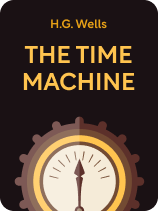

This article is an excerpt from the Shortform book guide to "The Time Machine" by H.G. Wells. Shortform has the world's best summaries and analyses of books you should be reading.
Like this article? Sign up for a free trial here.
In The Time Machine, how does the world end? Why does it end? What lessons can we draw from the story?
In The Time Machine, a Victorian scientist builds a machine that can travel through time. He journeys into the future, where humanity has evolved into two distinct (and conflicting) species. He then goes even further into the future and sees the end of the world.
Read on to learn about The Time Machine’s end-of-the-world scenario, when human civilization has collapsed.
The Prelude to the End of the World
To understand The Time Machine’s end-of-the-world scenario, we must look at the decay that eventually leads to collapse. Near the end of the Time Traveller’s exploration of the world in the year 802701, he finds several useful items. Inside the ruins of a museum, he breaks a large metal lever off of an old machine to use as a weapon. Then, in a library filled with decayed books, he finds a box of matches and a jar of camphor (a chemical compound that burns quickly and brightly).
(Shortform note: The ruined museum and library are signs of civilization’s decay—they’re places associated with culture and education, which the Eloi and Morlocks apparently have no interest in. Only the Time Traveller, who possesses human knowledge and ingenuity, is able to recognize and use the things inside them.)
At this point the Time Traveller decides to go back to the garden, hoping that he can use the lever to break open the pedestal and get his machine back. However, the Morlocks pursue him and Weena, eventually surrounding them and trapping them in the woods. The Time Traveller builds a fire to keep the Morlocks away, and he and Weena fall asleep.
The Morlocks attack during the night despite the fire. The Time Traveller kills several of them with the broken lever, and the rest run away. He then realizes that the fire he started has spread to the surrounding trees, and Weena has disappeared, so he runs alone out of the woods to safety.
Once the sun rises the Time Traveller searches for Weena again. However, he still can’t find her, and he concludes that she must have died in the fire. He’s briefly tempted to kill the Morlocks—who are helpless because of the light and heat from the forest fire—but decides against it.
When the Time Traveller makes it back to the garden he’d first arrived in, he’s surprised to see that the statue’s pedestal is already open. He knows it must be a Morlock trap, but he goes inside anyway since that’s the only way to get back to his time machine. The Morlocks attack as he expects, but he manages to fight through them, reattach the control levers for the time machine, and escape further into the future.
| Did the Loss of Creativity Doom Society? Creativity is a distinctly human trait that neither the Eloi nor the Morlocks display. In A First-Rate Madness, psychiatrist Nassir Ghaemi defines creativity as the ability to identify problems that others haven’t noticed and to come up with innovative solutions for those problems. However, the Eloi and the Morlocks don’t seem to innovate at all—they just follow routines and become frightened or angry when something disrupts those routines. One thing Wells never explicitly tells us is why civilization collapsed. The only explanation we get is the Time Traveller’s guess that the ruling class drove the working class underground, and over time they evolved into the Eloi and the Morlocks, respectively. However, that doesn’t really answer the question: Why couldn’t these new species keep society and culture from falling apart (or, alternatively, why didn’t they)? The loss of creativity would explain it. If humanity somehow lost the ability to be creative—to identify new problems and devise solutions for them—all progress would stop. Without creativity, at best we could only keep society as it currently is. In fact, that’s exactly what the Morlocks do: They keep the ventilation system working and take care of the Eloi, but there are no signs of them trying to invent or discover new things. Furthermore, if new problems arose without people recognizing or solving them, civilization would eventually decay and collapse just as Wells describes. For example, suppose the world’s supply of fossil fuels ran out. Without the ability to innovate new sources of energy and fuel, we’d suffer widespread power outages, and many of our machines (including cars) would stop working. The impact on society would be devastating and permanent. |
The End of the World
In his escape from the Morlocks, the Time Traveller leaps many millennia into the future. Watching from inside his time machine, he sees that the sun is getting bigger and redder as he travels, and the Earth is turning more and more slowly.
(Shortform note: Our sun will eventually become a red giant—a dying star with no hydrogen left to fuel it—as Wells describes here. However, NASA estimates that will happen around six billion years from now, not 30 million years.)
He finally stops the machine at an unspecified time in the distant future. The Time Traveller finds himself in a world of lush plants and enormous animals but sees nothing humanoid.
(Shortform note: There’s a trend in how Wells envisions the future—as humans change into Eloi and Morlocks, then die out entirely, nature recovers and plants and animals thrive. In The World Without Us, Alan Weisman discusses how that recovery might happen and how long it would take. Weisman hypothesizes that, about 250,000 years after humans go extinct, the last remnants of our civilization (the plutonium in our nuclear weapons and reactors) will finally finish decaying, leaving Earth almost as though we’d never existed. In contrast with Wells, whose Time Traveller is horrified by a future in which humans are extinct, Weisman presents a hopeful future in which the Earth recovers from the damage humans have caused.)
After that stop, the Time Traveller continues into the future. He begins briefly stopping every thousand years to study his surroundings. There are fewer plants and animals each time he stops, and the Time Traveller concludes that the entire Earth is slowly dying.
Finally, about 30 million years into the future, he stops for a longer time to observe the state of the world more closely. The air in this time period is thin and extremely cold. The sun is now fully red and takes up a large section of the sky.
The Time Traveller sees nothing living except for some mosses and lichens, and a creature that looks like a black octopus roughly the size of a soccer ball flopping weakly in the ocean shallows. It begins to snow, then the sky turns dark and he realizes he’s seeing a solar eclipse.
The Time Traveller is horrified and sickened by this bleak view of the end of the world. Eventually the eclipse ends, and the returning light brings the Time Traveller to his senses. He returns to his machine and starts the journey back to his own time.
| The End of the World as a Memento Mori The end of the world (or, at least, the end of the world as we know it) is a subject that Wells wrote about more than once. For another example, his famous story The War of the Worlds is about how the world nearly ends when Martians invade. Some scholars say that Wells wrote such stories as warnings in order to shock his readers and scare them into supporting his vision of a unified, socialist world government. However, while that’s a good interpretation of A.D. 802701—after civilization collapsed because of a divided, capitalist society—it doesn’t explain this vision of the end of the world. After all, when the whole world is dying, it won’t matter what kind of government or economy people used to have. Instead, it’s possible that this part of The Time Machine is a different kind of warning, intended to make readers confront the idea of mortality. In other words, just like the Time Traveller, the readers have to grapple with the idea that everything on Earth (including themselves) will eventually die. While this is a terrifying idea for many people, some psychologists say that a healthy view of death can actually bring new meaning to your life. Remembering that your time is limited can inspire you to make the most of that time and to chase your dreams while you can. |

———End of Preview———
Like what you just read? Read the rest of the world's best book summary and analysis of H.G. Wells's "The Time Machine" at Shortform.
Here's what you'll find in our full The Time Machine summary:
- An overview and analysis of H.G. Wells's 1895 science fiction novel
- A look at the science behind the story—what's real and what's fiction
- The literary techniques and symbolism Wells used to craft the story






